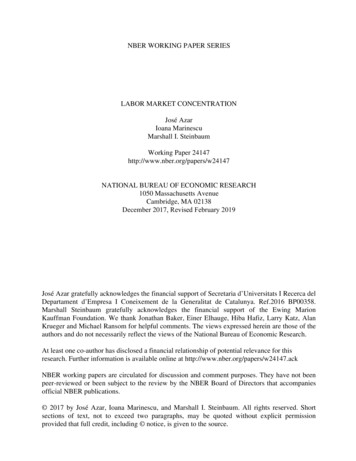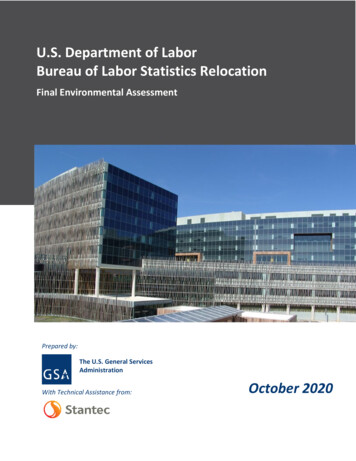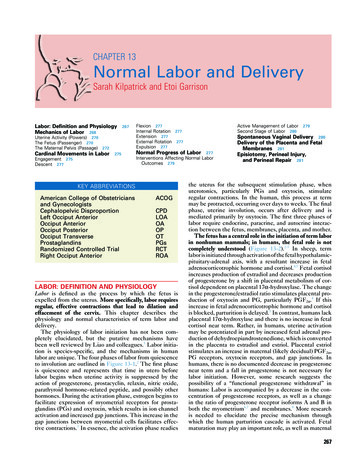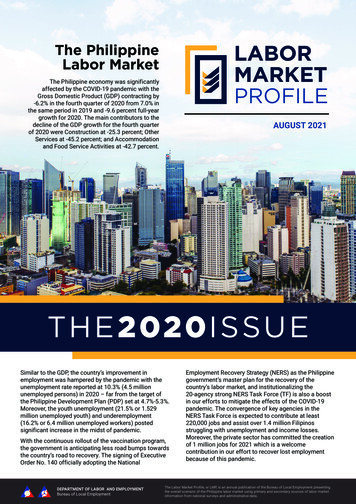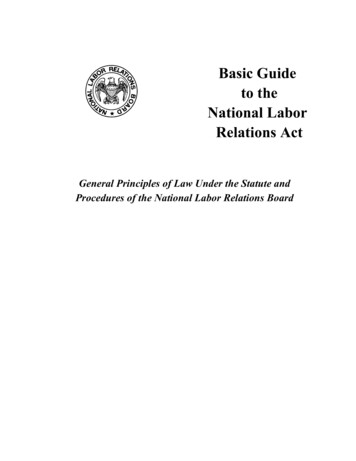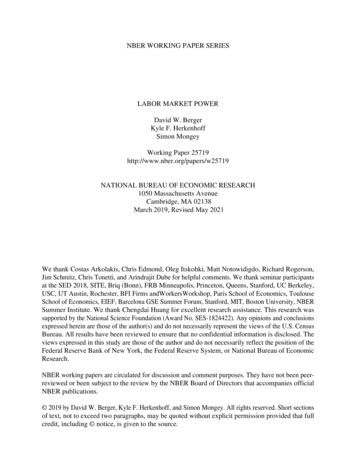
Transcription
NBER WORKING PAPER SERIESLABOR MARKET POWERDavid W. BergerKyle F. HerkenhoffSimon MongeyWorking Paper 25719http://www.nber.org/papers/w25719NATIONAL BUREAU OF ECONOMIC RESEARCH1050 Massachusetts AvenueCambridge, MA 02138March 2019, Revised May 2021We thank Costas Arkolakis, Chris Edmond, Oleg Itskohki, Matt Notowidigdo, Richard Rogerson,Jim Schmitz, Chris Tonetti, and Arindrajit Dube for helpful comments. We thank seminar participantsat the SED 2018, SITE, Briq (Bonn), FRB Minneapolis, Princeton, Queens, Stanford, UC Berkeley,USC, UT Austin, Rochester, BFI Firms andWorkersWorkshop, Paris School of Economics, ToulouseSchool of Economics, EIEF, Barcelona GSE Summer Forum, Stanford, MIT, Boston University, NBERSummer Institute. We thank Chengdai Huang for excellent research assistance. This research wassupported by the National Science Foundation (Award No. SES-1824422). Any opinions and conclusionsexpressed herein are those of the author(s) and do not necessarily represent the views of the U.S. CensusBureau. All results have been reviewed to ensure that no confidential information is disclosed. Theviews expressed in this study are those of the author and do not necessarily reflect the position of theFederal Reserve Bank of New York, the Federal Reserve System, or National Bureau of EconomicResearch.NBER working papers are circulated for discussion and comment purposes. They have not been peerreviewed or been subject to the review by the NBER Board of Directors that accompanies officialNBER publications. 2019 by David W. Berger, Kyle F. Herkenhoff, and Simon Mongey. All rights reserved. Short sectionsof text, not to exceed two paragraphs, may be quoted without explicit permission provided that fullcredit, including notice, is given to the source.
Labor Market PowerDavid W. Berger, Kyle F. Herkenhoff, and Simon MongeyNBER Working Paper No. 25719March 2019, Revised May 2021JEL No. E2,J2,J42ABSTRACTTo measure labor market power in the US economy, we develop a tractable quantitative, generalequilibrium, oligopsony model of the labor market. We estimate key model parameters bymatching the firm-level relationship between labor market share and employment size and wageresponses to state corporate tax changes. The model quantitatively replicates quasi-experimentalevidence on (i) imperfect productivity-wage pass-through, (ii) strategic behavior of dominantemployers, and (iii) the local labor market impact of mergers. We then measure welfare lossesrelative to the efficient allocation. Accounting for transition dynamics, we quantify welfare lossesfrom labor market power relative to the efficient allocation as roughly 6 percent of lifetimeconsumption. An analytical decomposition attributes equal parts to dead-weight losses andmisallocation. Lastly, we find that declining local concentration added 4 ppt to labor’s share ofincome between 1977 and 2013.David W. BergerDepartment of EconomicsDuke University419 Chapel DriveSocial Science Building 231Durham, NC 27708and NBERdavid.berger@duke.eduKyle F. HerkenhoffUniversity of MinnesotaDepartment of Economics4-101 Hanson Hall1925 Fourth Street SouthMinneapolis, MN 55455and IZAand also NBERkfh@umn.eduSimon MongeyKenneth C. Griffin Department of EconomicsUniversity of Chicago1126 E. 59th StreetChicago, IL 60637and NBERmongey@uchicago.edu
Figure 1: Cross-market distribution of concentration: Longitudinal Business Database, 2014.Notes: Panel A plots the distribution of number of firms in markets. Panels B plots the across market distribution of the payrollHerindahl index ( HH Ijwn ). Bins are determined by the following bounds: {0, 0.10, 0.25, 0.50, 0.75, 0.99, 1}. Horizontal axis givesthe mean in each bin. Blue line (solid squares) gives the distribution of markets, red line (dashed crosses) gives the distributionof total wage payments. Data is Census LBD for the whole US economy in 2014. Market is defined as a commuting zone andNAICS 3-digit industry. See Appendix C for additional details. Table A2 provides additional data on employment HH I’s.In the average local labor market in the U.S., there are many firms but employment and wages areconcentrated in only a few. Defining a labor market as a commuting zone and three-digit industry, theaverage number of firms is over 100, while the weighted average level of market concentration is 0.11,the same level of concentration one would observe with only 9 equally sized firms (Figure 1).1 Thishas led to the growing concern that these firms may exert “labor market power” over their workers,generating large welfare losses.2 In this paper, we measure the amount of oligopsony power in labormarkets and quantify its consequences for welfare. We do so by developing a tractable, quantitative,general equilibrium model with differentially concentrated local labor markets in which firms behavestrategically under an oligopsony equilibrium. These novel features allow the model to match empiricalregularities in the labor literature such as incomplete wage pass-through and strategic competitor wageresponses that a standard monopsony model misses. The model delivers a structurally consistent formulation of labor market power and a framework for understanding the mechanisms behind potentialwelfare losses.Our benchmark oligopsony model features two sources of market power. The first is classical monopsony: atomistically small firms face upward sloping labor supply curves due to preference heterogeneity,which they internalize (Burdett and Mortensen, 1998; Manning, 2003; Card, Cardoso, Heining, and Kline,2018; Lamadon, Mogstad, and Setzler, 2019). Optimal wages are a markdown relative to competitivewages, i.e. the marginal revenue product of labor. Second, motivated by Figure 1 and the focus of thispaper, is oligopsony: firms are non-atomistic and compete strategically for workers, further internalizinghow they expect other employers to respond to their hiring and wage policies. This strategic interaction1 Appendix Table F2 reports 113 firms per market across all industry codes. Appendix C provides additional market levelsummary statistics.2 For example: Azar, Marinescu, and Steinbaum (2020), Benmelech, Bergman, and Kim (2020), Card, Cardoso, Heining, andKline (2018), and Lamadon, Mogstad, and Setzler (2019).1
leads to large equilibrium markdowns at the most productive firms and provides a second source of welfare loss. Understanding the welfare consequences of labor market power requires understanding howthese markdowns vary across firms. In our model, the markdown is an exact function of the structurallabor supply elasticity that a firm faces in equilibrium which—via a closed-form—depends on the firm’sobservable labor market share and parameters that determine how easily labor is reallocated across- (θ)and within- (η) markets.We estimate the model on U.S. Census data, and derive three main results. First, the framework isquantitatively consistent with documented empirical regularities suggestive of oligopsony: incompletewage pass-through, strategic competitor wage responses, and size-dependent post-merger wage dynamics. A monopsony version of our model cannot qualitatively match these empirical regularities. Second,the model implies substantial welfare losses from labor market power, both across steady states andalong the transition path to an efficient allocation. Welfare losses are large, ranging from 4 to 9 percent oflifetime consumption depending on wealth effects. A representative agent counterpart to our economydelivers equilibrium aggregate prices and quantities and decomposes welfare loss into two components:(1) a dead-weight loss due to average markdowns, (2) a misallocation effect due to wider markdowns atmore productive firms. While the former exists under monopsony, the latter does not. We show that bothchannels account equally for welfare losses. Third, despite these large losses, we find that labor marketpower has not contributed to the declining labor share. Despite the backdrop of stable national concentration, we find that the model-consistent measure of local concentration, which we measure for the firsttime, has declined over the last 35 years, indicating that most local labor markets are more competitivethan they were in the 1970s.3In terms of the general equilibrium theory of the model, we prove two properties that are centralto our main applications. First, we show that our model is block recursive, meaning that local labormarket equilibrium is independent of aggregates. This allows us to estimate the model quickly anddecompose welfare for arbitrary aggregate preferences. Second, we provide a closed-form relationshipbetween labor’s share of income and local payroll concentration. Our model-relevant measure of payrollconcentration is new to the literature. We use our formula to measure the contribution of changes inlocal payroll concentration on labor’s share of income.In terms of estimation of the model, strategic interaction complicates the identification of the keyparameters by violating exclusion restrictions that are otherwise applicable in monopsonistically competitive models. We address this issue by integrating into our structural estimation the first reducedform estimates of the size dependence of employment and wage responses to state corporate taxes. Weestimate our key parameters using U.S. Census Longitudinal Business Database (LBD) micro data (seeFigure 2). Given a quasi-experiment that yields an identified shock to labor demand, a researcher canestimate reduced-form labor supply elasticities off of relative employment and wage responses. The literature so far has assumed a special case of our model: firms do not behave strategically, rationalized by3 In contemporaneous work Rinz (2018) also uses Census data and shows similar patterns for alternative measures of concentration. These measures are not exactly those that are welfare relevant for the model. Rossi-Hansberg, Sarte, and Trachter(2018) use NETS data and find similar patterns in sales and employment concentration.2
Figure 2: Estimation strategyinfinitely many firms in each labor market.4 This assumption abstracts from competitor equilibrium bestresponses, and implies that empirically estimated reduced-form elasticities are equal to structural elasticities,so one can move directly from empirical analysis to welfare analysis. In the more general case of granular labor markets, there is no closed-form mapping between (observed) reduced-form elasticities and(unobserved) structural elasticities.5 A model is needed to account for the equilibrium best responsesthat determine the mapping between underlying structural parameters and the reduced-form elasticitieswe observe.Our approach is therefore indirect inference. Our quasi-experiment is an extension of Giroud andRauh (2019). We exploit state corporate tax rate changes to estimate reduced-form elasticities. We extendtheir methodology to characterize how they relate to a firm’s local labor market share. We then simulatetax changes in our model and determine the structural parameters that minimize the distance betweenthe profile of reduced-form elasticities by market share in model and data. The estimated model is thenused to compute structural elasticities, markdowns, and conduct welfare counterfactuals.6This departure from the literature contributes three additional results. First, in the data, responsesof firms to labor demand shocks vary systematically: firms with smaller market shares have statistically significantly larger reduced-form elasticities than firms with larger market shares. Second, in ourparticular experiment, reduced-form elasticities at small firms are around 2, but welfare-relevant structuralelasticities are around 7. Filtering the data through the model is necessary to uncover the high laborsupply elasticities faced by small firms. Third, we explore bias in more common empirical settings that4 Papersin the literature that study strategic behavior have been theoretical, which we discuss below.finitely many firms case is indeed more general. That is, a ‘competitive’ monopsony model is indeed a special case ofour model. Taking the number of firms in all markets in our model toward infinity smoothly yields the ‘competitive’ economyin which there is no strategic interaction. We let the data tell us where we are on this spectrum between one and infinitely manyfirms per market.6 This procedure has a direct counterpart in the estimation of linearized state-space systems in macroeconomics: AX tBE[ X t 1 ] CX t 1 Dε t . The structural model implies a reduced-form VAR representation: X t 1 HX t Fet 1 . The researcherfirst estimates the reduced-form on the data to obtain reduced-form shocks {bet }tT 0 . They then simulate structural shocks {ε t }tT 0in the model and jointly estimate structural parameters { A, B, C, D } and structural shocks {ε t }tT 0 such that the model impliedreduced-form shocks match those obtained from the data.5 The3
exploit purely idiosyncratic variation. Here results are different; when we account for the new marketequilibrium, structural elasticities are always less than empirically estimated reduced-form elasticities, oftenby a large amount. A researcher using reduced-form estimates for welfare analysis would infer flat laborsupply curves and understate the degree of labor market power.We validate the estimated model by replicating three reduced-form experiments that distinguisholigopsony from monopsonistic competition and find in all cases that our model estimates are withinthe 95% confidence interval of the published estimates. First, we replicate the 0.47 pass-through fromlog value added per worker to log wages in Kline, Petkova, Williams, and Zidar (2019), producing 0.61in our model. Second, we replicate the 0.13 response elasticity of competing hospital’s wages to VAhospital wage increases in Staiger, Spetz, and Phibbs (2010), producing 0.07 in our model. Third, wereplicate the 0.8 percent decline in worker wages following a merger in Arnold (2020a), producing a1.3 percent decline in our model, and matching a 3 times larger decline in more concentrated markets.Theoretically, we prove that a monopsonistically competitive economy features a pass-through of one,a competitor response elasticity of zero, and no effect of mergers on competitors. These tests provideevidence that oligopsony is necessary to fit key empirical regularities in the reduced-form literature.With our model calibrated to aggregates and local labor markets, we define the welfare loss due tolabor market power as the consumption subsidy required to make households indifferent between theoligopsonistic economy and the efficient allocation that a planner would choose. Comparing steadystates at an aggregate Frisch elasticity of labor supply of 0.50, we measure a welfare loss of 7.0 percent. Competitive equilibrium wages, output and labor supply are significantly greater. Welfare lossesare slightly lower (5.7 percent) when accounting for macroeconomic transition dynamics between thesetwo labor market structures. We show that these results are robust to aggregate preferences being ofGreenwood Hercowitz Huffman (1988, henceforth GHH) or balanced growth types.7We explore the mechanisms underlying these large welfare losses using a novel representative agentcounterpart to our economy. We decompose output losses into two components. The first componentis an aggregate markdown which reflects pure dead-weight loss from oligopsony power. The secondcomponent is an aggregate efficiency loss that reflects misallocation. Productive firms have the mostlabor market power and widest markdowns. They therefore restrict employment the most. This results in an inefficient under allocation of employment at the most productive firms and the wider theproductivity distribution, the larger the wage mark-downs and subsequent efficiency losses. Overall,we find that roughly 50 percent of welfare losses are driven by misallocation, 40 percent are due topure markdowns, and the remainder is due to their interaction.8 This would not be the case in a standard monopsonistically competitive environment. We show that the misallocation effect is zero undermonopsonistic competition, so strategic interactions and markdown heterogeneity account for roughlyhalf of the losses observed.7 With more significant wealth effects on labor supply, welfare losses are smaller, but still exceed 4 percent even with acoefficient of relative risk aversion of four. With a higher Frisch elasticity of labor supply, welfare losses are larger. Under anaggregate Frisch of 0.2 (0.8), welfare losses are 4.8 (9.28 With more significant wealth effects on labor supply, welfare losses due to misallocation increases. With a higher Frischelasticity of labor supply, welfare losses due to the aggregate markdown increases.4
A symptom of the misallocation present in the benchmark economy is that the planner’s solutionhas greater concentration, employment, and wages. In the oligopsonistic economy, large firms are inefficiently small, so any policy that decentralizes the efficient allocation would reallocate more employmentto already large firms. Aggregate concentration roughly doubles, employment increases by 11 percentand the average wage increases by 48 percent.We conclude by applying the model to study the relationship between local labor market concentration and the labor share. Despite large welfare losses from labor market power, we find that declininglocal labor market concentration between 1977 and 2013 increased labor’s share of income. First, lettingour model guide measurement, we show that the distribution of market-level payroll Herfindahls canbe used to compute a sufficient statistic for labor’s share of income, with a relationship that is independent of the aggregate labor supply elasticity and wealth effects.9 Second, the model implies that thesemicro measures should be aggregated using market-level payroll weights, shown in red in Figure 1B.We construct this model relevant concentration measure directly from the Census LBD and find it hasdeclined from 0.16 to 0.11 between 1977 and 2013.10 Ignoring these weights would double the level ofconcentration and imply a stable trend.11 We feed our measure into our formula for labor’s share ofincome under the estimated preference parameters (θ, η ). We find that declining local labor market concentration would have implied a counterfactual 4 percentage point increase in labor’s share of income.Changing labor market concentration is not behind the declining labor share.12We review the literature and then proceed as follows. Sections 1 lays out the model and characterizesthe equilibrium. Section 2 provides empirical estimates of the relationship between reduced-form laborsupply elasticities and market share, then combine this relationship and our new concentration statisticsto parameterize the model. Section 3 validates the model via replication of three empirical studies.Section 4 presents our main welfare measurement exercises. Section 5 applies the model to measurewelfare-relevant aggregate concentration and the labor share.Literature.Our work is related to a growing literature that explores the implications of market power.In the product market, Gutiérrez and Philippon (2017); Autor, Dorn, Katz, Patterson, and Van Reenen(2020) all document an increase in national sales concentration and a fall in the labor share across manyindustries, while De Loecker, Eeckhout, and Unger (2020) document an increase in product marketpower more directly by measuring firm markups. Consistent with our findings, concurrent work byRossi-Hansberg, Sarte, and Trachter (2018) documents declining regional employment concentration,despite rising national concentration. In the labor market, several concurrent studies have documented9 Themarket-level wage-bill Herfindahl is the sum of the squared payroll shares of all firms within the labor marketmeasures of concentration are equivalent to what would be obtained with 6.25 equally sized firms per market in1977, and 9.43 equally sized firms per market in 2013.11 Our model replicates the distribution and means of both weighted and unweighted Herfindahls in the data. The largedifference between weighted and unweighted Herfindahls is due to the fact that 11 percent of markets have one firm, andthus a Herfindahl of 1, yet these markets only comprise 0.18 percent of aggregate payroll. Moreover, the payroll share ofconcentrated markets is falling, presumably as individuals leave highly concentrated rural markets for less concentrated citymarkets.12 Interestingly, in their recent paper on the dynamics of the labor share, Kehrig and Vincent (2021) find evidence consistentwith our results, as employment reallocation is roughly independent of output reallocation (see their Fig. III).10 These5
cross-sectional and time-series patterns of U.S. Herfindahls in employment (Benmelech, Bergman, andKim, 2020; Rinz, 2018; Hershbein, Macaluso, and Yeh, 2020) and vacancies (Azar, Marinescu, Steinbaum,and Taska, 2020; Azar, Marinescu, and Steinbaum, 2020). Brooks, Kaboski, Li, and Qian (2019), Hershbein, Macaluso, and Yeh (2020), and Chan, Salgado, and Xu (2020) use tools from industrial organizationto identify wage markdowns and heterogeneous pass-through rates consistent with the theory in thispaper. Our contributions to this literature are (i) a new, model consistent, measure of U.S. labor marketconcentration, which we use to (ii) quantitatively measure the welfare losses associated with labor market power. In general, the exercises in our paper issue a warning against qualitatively mapping changesin concentration into a change in welfare.Our work is also related to a large literature measuring reduced-form labor supply elasticities ofindividual firms (Staiger, Spetz, and Phibbs, 2010; Webber, 2015; Card, Cardoso, Heining, and Kline,2018; Suárez Serrato and Zidar, 2016; Dube, Jacobs, Naidu, and Suri, 2020). We provide new estimatesof measured labor supply elasticities by building on the approach of Giroud and Rauh (2019), whofind significant effects of state corporate taxes on firm-state employment.13 Our contributions to thisempirical literature are (i) estimates of the share-dependency of measured elasticities that point to largefirms having more market power (ii) to demonstrate that if markets have firms that interact strategically,there can be a large disconnect between measured labor supply elasticities and the structural elasticitiesthat are relevant for welfare. This is a substantive point: the empirical literature cited above typicallymeasures labor supply elasticities that are small. If structural elasticities were equal to these reducedform elasticities, then labor market power would be extremely high.14 We describe empirical designsunder which (i) reduced-form estimates of labor supply elasticities may be biased downwards relativeto structural elasticities, and even then, (ii) that structural elasticities vary systematically with the firm’slabor market share, and show that this reconciles the range and level of empirical estimates.Finally, our work is related to the large literature that models monopsony in labor markets. We depart from benchmark models of monopsony described in (Burdett and Mortensen, 1998; Manning, 2003;Card, Cardoso, Heining, and Kline, 2018; Lamadon, Mogstad, and Setzler, 2019; Kroft, Luo, Mogstad,and Setzler, 2020) by explicitly modeling a finite set of employers that compete strategically for workers. We demonstrate that this addition is crucial for identification: strategic interaction and finitenessof firms jointly imply that reduced-form empirical estimates of labor supply elasticities from any shockcannot be used to infer the (structural) labor supply elasticities firms face—and hence identify preference parameters—except in the limiting case of monopsonistic competition between infinitesimally sizedfirms. Additionally, our assumptions allow us to (i) interpret granular measures of concentration, suchas Herfindahl indexes, and (ii) accommodate a planning problem that allows us to define an efficientbenchmark.13 Conceptually,our approach is related to papers that estimate exchange rate pass-through (Amiti, Itskhoki, and Konings,2014, 2019). The main difference is that this literature focuses exclusively on prices, whereas we look at both price and quantityresponses.14 Consider Manning (2011) discussing the widely cited natural experiments of Staiger, Spetz, and Phibbs (2010) and others:“Looking at these studies, one clearly comes away with the impression not that it is hard to find evidence of monopsony power but that theestimates are so enormous to be an embarrassment even for those who believe this is the right approach to labour markets.”6
Our main quantitative contribution is to build a general equilibrium model of oligopsony and measure the welfare costs of current levels of U.S. labor market power.15 Our framework extends the generaltools developed in Atkeson and Burstein (2008) to the labor market, adding multiple non-trivial features:capital, corporate taxes, decreasing returns to scale, setting the model in general equilibrium, and studying transition dynamics between steady states. Recent related work by Jarosch, Nimcsik, and Sorkin(2019) considers non-atomistic firms, but adapts a random search model to construct a search-theoreticmeasure of labor market power. We view our papers as complementary.Our model features firm-specific upward sloping labor supply curves. This is supported by numerous recent studies using (quasi-)experimental approaches.16 Belot, Kircher, and Muller (2017) randomlyassign higher wages to observationally equivalent vacancies on an actual job-board and find that higherwage vacancies attract more applicants. Dube, Jacobs, Naidu, and Suri (2020) and Banfi and VillenaRoldan (2018) also find job-specific upward sloping labor supply curves in well-identified contexts.17Finally, our quantitative model features strategic complementarity between oligopsonists. Strategiccomplementarity in labor markets is not new to the theoretical literature. The earliest models used tomotivate monopsony power were Robinson (1933) and the spatial economies of Hotelling (1990) andSalop (1979).18 Our contribution relative to these stylized single-market models, is a quantitative general equilibrium framework. We incorporate firm heterogeneity, decreasing returns to scale, and generalequilibrium across multiple markets, such that the model is rich enough to be estimated on U.S. Census data. Moreover, by modeling a finite set of employers, our model may be used in the future tounderstand the wage and welfare effects of mergers, firm exit, and other shocks to local labor marketcompetition. Very recent work by Azkarate-Askasua and Zerecero (2020) and MacKenzie (2019) alsoestimate models with strategic interactions using French and Indian data, respectively. Our contributionis to develop a quantitative general equilibrium framework and develop a methodology to consistentlyestimate the underlying preference parameters governing oligopsony.1Model1.1EnvironmentAgents. The economy consists of a representative household and a continuum of firms. The householdconsists of a unit measure of atomistic, homogeneous workers each with one unit of labor supply. Firmsare heterogeneous in two dimensions. First, firms inhabit a continuum of local labor markets j [0, 1],each with an exogenous and finite number of firms indexed i {1, 2, . . . , m j }. Second, firms’ productivities zijt (0, ) are drawn from a location invariant distribution F (z). The only ex-ante difference15 Ourwork is therefore related to a literature measuring the welfare consequences of misallocation. There the focus hasbeen on the product market (Baqaee and Farhi, 2020; Edmond, Midrigan, and Xu, 2018), and measures misallocation via heterogeneous markups. Our paper measures misallocation from heterogeneous mark-downs.16 See Ashenfelter, Farber, and Ransom (2010) for a summary of prior papers.17 We are unaware of experimental evidence regarding the market-share dependence of the elasticity of labor supply.18 Boal and Ransom (1997) and Bhaskar, Manning, and To (2002) provide excellent summaries of strategic complementarityin spatial models of the labor market.7
between markets is the number of firms m j {1, . . . , }. Time subscripts are necessary in that we studywelfare counterfactuals on transition paths between steady-states, but productivity and number of firmsare constant at the firm- and market-level, respectively.Goods and technology.The continuum of firms produce tradeable goods that are perfect substitutes,and so trade in a perfectly competitive national market at a price Pt that we normalize to one. Firmsoperate a value-added production function that uses inputs of capital k ijt and labor nijt .19 A firm producesyijt units of net-output (value-added) according to the production function: 1 γ γ α, γ (0, 1) , α 0.yijt zijt k ijt nijtThe degree of returns to scale α is unrestricted and later estimated. The household uses these goodsfor consumption and investment. Investment augments the capital stock Kt , which is rented to firmsin a competitive market at price Rt and depreciates at rate δ. To the best of our knowledge this is thefirst paper to model imperfect competition, either in input or output markets, with finitely many firmsand decreasing returns to scale in general equilibrium. To model imperfect competition we extend toolsdeveloped in the trade literature (Atkeson and Burstein, 2008).1.2HouseholdPreferences and problem. The household chooses the measure of workers to supply to each firm nijt ,investment in next period capital Kt 1 , and consumption of each good cijt to maximize their net presentvalue of utility. Given an initial capital stock K0 , the household solves
Labor Market Power David W. Berger, Kyle F. Herkenhoff, and Simon Mongey NBER Working Paper No. 25719 March 2019, Revised May 2021 JEL No. E2,J2,J42 ABSTRACT To measure labor market power in the US economy, we develop a tractable quantitative, general equilibrium, oligopsony model of the labor market. We estimate key model parameters by
